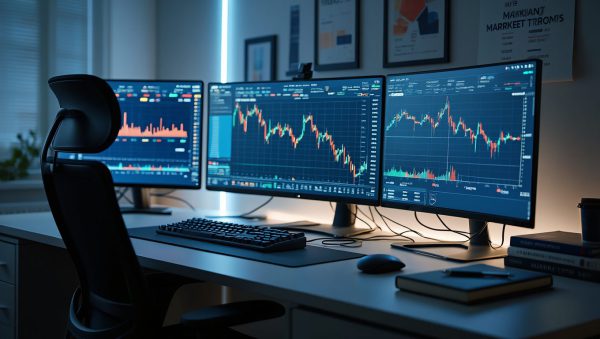
How to Calculate Trends with the Simple Moving Average Formula
Apr 7, 2025
Fear is a great manipulator. It clouds judgment, drives irrational decisions, and fuels the herd mentality that has destroyed more wealth than any bear market. When panic grips the markets, it spreads like fire—fast, destructive, and indiscriminate. Investors sell not because they’ve analyzed the data, but because the crowd is running, and fear tells them to follow. Yet, in this chaos, there is opportunity. For those who understand the tools of technical analysis, the noise of the herd becomes a signal. The simple moving average formula is one such tool—a weapon to cut through the confusion, revealing trends hidden beneath the surface.
But make no mistake: the moving average doesn’t predict the future. It doesn’t guarantee success. Instead, it gives you clarity—an objective lens through which to view price action, stripped of emotion, hype, and fear. To harness its power, you must first understand its purpose, its calculation, and its role in navigating the inherently nonlinear chaos of financial markets. This is where your journey begins: not with blind predictions but with disciplined analysis.
Exposing Market Panic: Fear as a Catalyst for Chaos
To understand the importance of the simple moving average formula, you must first understand the enemy: fear-driven herd mentality. Fear is a survival instinct. In the wild, running with the herd could save your life. But in markets, it’s a killer. It forces investors to sell at the bottom, buy at the top, and ignore the objective reality of trends unfolding before their eyes.
Consider the financial crisis of 2008. As the housing market collapsed and Lehman Brothers fell, panic swept through the market like a contagion. The S&P 500 plummeted, and millions of investors sold their holdings, locking in catastrophic losses. But the contrarians—the ones who ignored the panic, studied the charts, and relied on objective tools like moving averages—saw opportunity. They recognized the long-term uptrend beneath the noise, buying when fear paralysed others. The result? Wealth was transferred from the impatient to the disciplined.
The simple moving average is not just a mathematical formula; it’s a psychological anchor. It forces you to see the market as it is, not as your emotions perceive it. By smoothing out short-term fluctuations, it reveals the dominant trend and helps you resist the urge to follow the herd. And in a world where fear and greed rule, that clarity is priceless.
The Simple Moving Average Formula: Decoding the Basics
At its core, the simple moving average (SMA) is exactly what it sounds like: the average of a security’s closing prices over a specified period. The calculation itself is straightforward:
SMA = (P1 + P2 + P3 + … + Pn) / n
Where P represents the closing prices, and n is the number of periods used. For example, if you’re calculating a 10-day SMA, you simply add up the closing prices of the last 10 days and divide by 10. Each day, the calculation shifts forward, creating a moving average that reflects the most recent data.
The beauty of the SMA lies in its simplicity. It smooths out price fluctuations, allowing you to identify trends that might otherwise be obscured by volatility. But its value goes beyond calculation—it’s a lens through which you can view market behavior, a tool that transforms chaos into clarity.
Think of the SMA as a filter. In physics, filters are used to isolate specific frequencies of light or sound. Similarly, the SMA isolates trends, filtering out the “noise” of short-term price movements. By plotting the SMA on a chart, you can visualize the market’s trajectory, identifying support and resistance levels, crossovers, and other key signals. But remember: the SMA is not predictive. It’s reactive. It shows you where the market has been, not where it’s going. To use it effectively, you must combine it with a disciplined strategy and a deep understanding of market dynamics.
Contrarian Mastery: Using the SMA to Exploit Fear
The simple moving average formula doesn’t just reveal trends—it exposes opportunities that fear blinds others to. Contrarian investors thrive on these moments, using tools like the SMA to identify when the herd is wrong. Here’s how:
1. Identifying Overreactions
Fear often drives markets to extremes. When prices deviate significantly from their moving averages, it’s often a sign of overreaction. Consider the COVID-19 market crash in March 2020. As panic gripped the world, the S&P 500 plunged well below its long-term moving averages. But contrarians saw this as a buying opportunity, recognizing that the fundamentals hadn’t changed as dramatically as fear suggested. By combining the SMA with other indicators, they positioned themselves for the following rapid recovery.
2. Spotting Crossovers
One of the most powerful signals in technical analysis is the crossover. When a short-term moving average (e.g., 20-day) crosses above a long-term moving average (e.g., 50-day), it signals a potential uptrend—a classic “golden cross.” Conversely, when the short-term average surpasses the long-term average, it signals a potential downtrend—a “death cross.” These signals, while not foolproof, provide objective entry and exit points for disciplined traders.
3. Combining SMA with Volatility
The SMA is most effective when combined with other tools, such as Bollinger Bands or the Relative Strength Index (RSI). For example, during periods of high volatility, prices often touch or break through the upper or lower Bollinger Bands. By comparing this behavior to the SMA, you can identify whether the move is a genuine breakout or a temporary overextension driven by emotion.
Disciplined Boldness: Turning Analysis into Action
Technical analysis is meaningless without execution. The simple moving average formula is only as powerful as the trader using it. To succeed, you must combine analysis with disciplined action—a rare combination in a world dominated by emotional decision-making.
Start by defining your strategy. Are you a long-term investor using the SMA to identify uptrend buying opportunities? Or are you a short-term trader, using crossovers and volatility signals to time your entries and exits? Whatever your approach, clarity and consistency are key. The SMA is not a magic bullet—it’s a tool, and like all tools, it requires skill to wield effectively.
Next, cultivate emotional discipline. The SMA won’t eliminate fear and greed, but it will give you a framework to resist them. When prices fall below the SMA, the herd will panic, selling at a loss. But you, armed with objective analysis, will see the opportunity to buy. When prices rise above the SMA, the herd will chase the trend, buying at inflated levels. But you, guided by discipline, will know when to take profits.
Finally, embrace the paradox of markets: they are both predictable and unpredictable. The SMA reveals patterns, but it doesn’t guarantee outcomes. To thrive, you must accept uncertainty, balancing confidence with humility. In the words of legendary trader Paul Tudor Jones, “The most important rule of trading is to play great defense, not great offense.” The SMA helps you do both, providing structure in a world of chaos.
Visionary Empowerment: Escaping the Herd
The simple moving average formula is more than a calculation—it’s a tool of empowerment. It frees you from the tyranny of emotional decision-making, giving you the clarity to act when others hesitate. It teaches you to see beyond the noise, to recognize the patterns that drive markets, and to position yourself for success in a world of uncertainty.
But this empowerment comes at a cost. To use the SMA effectively, you must abandon the herd’s comfort. You must embrace discipline, patience, and a willingness to think independently. You must accept that success in markets isn’t about following trends—it’s about understanding them.
The next time you face a market in turmoil, remember this: fear is the herd’s greatest weakness. But for the disciplined trader, it’s an opportunity. The simple moving average formula is your weapon—the tool that turns chaos into clarity, noise into signal, and fear into profit. The question is, will you use it?










